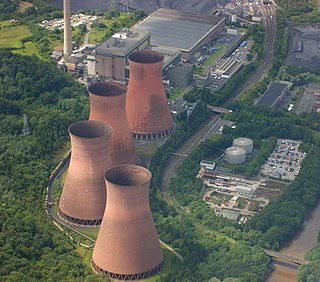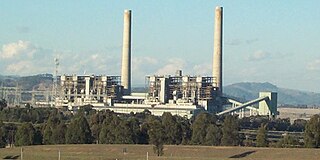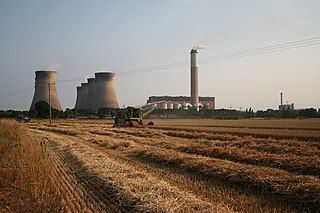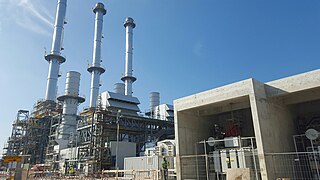Shutdown
When the Delimara Power Station was planned, the government had promised to close the Marsa power plant, but this did not happen. [1]
Enemalta wants to expand the Delimara power plant as a replacement for the Marsa power plant by mid 2012. It was switched off in March 2015 and continued in cold standby until early 2017; since then it has been disconnected from the mains. Enemalta plc contractors have completed the dismantling and demolition of the Marsa Power Station, paving the way for the long-awaited regeneration of this inner Grand Harbour area.
After the last two chimneys of the Marsa Power Station were pulled down, the few remaining structures on site, including one of the turbine halls and several fuel tanks, were removed to complete the project on schedule. The site has been cleared of all electricity generation equipment and buildings, down to ground level.
The dismantling and demolition of the 1953 Marsa Power Station included the gradual removal of the power station’s eight heavy fuel oil-fired units, and several other related structures, as soon as they were no longer required for electricity generation or as emergency capacity on cold standby. The dismantling process started in October 2014, a few months before the power station was switched off for the last time in March of the following year. Works on site gathered pace in the beginning of 2017, when the new Delimara 4 Power Station was commissioned and the last remaining Marsa Power Station units on cold standby were disconnected from the national grid.
The demolition contractors removed over 12,000 tonnes of concrete and other building materials from the power station site. Another 17,000 tonnes of metals, including steel, copper and aluminium, and 320 tonnes of electricity cables were exported for recycling. All materials were separated on site and carted away in adherence to strict waste management procedures. Dust abatement and other pollution control measures were in place to safeguard the wellbeing of residents and workers in the area during the entire process.
The oldest parts of the Marsa Power Station, known as the A Station, including several underground tunnels beneath Jesuits Hill, were retained. These historic tunnels are being carefully used by Enemalta and Streamcast Technologies to house a number of international data centres. The tunnels are suited for this kind of development due to their security and stable, low temperatures. At the same time, data centre equipment installations do not require any structural modifications to the tunnel structures. The first of these data centres was inaugurated earlier this year.
A standalone diesel generator installed at the Marsa Power Station in 1990 for emergency is still on site next to other similar generators currently in use. [2]

The Ironbridge power stations refers to a series of two power stations that occupied a site on the banks of the River Severn at Buildwas in Shropshire, England. The Ironbridge B Power Station was operated by E.ON UK but the site is now owned by Haworth Group. The station stands near the Ironbridge Gorge World Heritage Site. Originally powered by coal, they were converted to use 100% biomass fuel. Ironbridge B Power Station stopped generating electricity on 20 November 2015, with the decommissioning process continuing into 2017. The main phase of the 27-month demolition process began at 11:00 GMT on 6 December 2019, commencing with the four cooling towers.

Cockenzie power station was a coal-fired power station in East Lothian, Scotland. It was situated on the south shore of the Firth of Forth, near the town of Cockenzie and Port Seton, 8 mi (13 km) east of the Scottish capital of Edinburgh. The station dominated the local coastline with its distinctive twin chimneys from 1967 until the chimneys' demolition in September 2015. Initially operated by the nationalised South of Scotland Electricity Board, it was operated by Scottish Power following the privatisation of the industry in 1991. In 2005 a WWF report named Cockenzie as the UK's least carbon-efficient power station, in terms of carbon dioxide released per unit of energy generated.

The Lakeview Generating Station was an Ontario Power Generation coal-burning station located in Lakeview, a community just east of Port Credit, in Mississauga, Ontario, Canada. The former station, constructed in 1958–1962, was located just east of Lakeshore Road and Cawthra Road. The four stacks of the station were known as the Four Sisters; the eight boilers of the generating plant all 'twinned' their emissions into common stacks. The station was a landmark for years and was shut down in April, 2005, after 43 years of service. The four stacks, which could be seen from as far away as Burlington to the west and downtown Toronto to the east, were demolished on June 12, 2006. The rest of the building was demolished on June 28, 2007.

The Ferrybridge power stations were a series of three coal-fired power stations on the River Aire near Ferrybridge in West Yorkshire, England, in operation from 1927 to 2016 on a site next to the junction of the M62 and A1(M) motorways.

Munmorah Power Station is a demolished coal-fired power station with four 350 MW English Electric steam driven turbo-alternators for a combined capacity of 1,400 MW. The station was located near Doyalson, on the shores of Lake Munmorah, New South Wales, Australia and was owned and operated by Delta Electricity, a company owned by the New South Wales Government.

Liddell Power Station is a decommissioned coal-fired thermal power station that had four 500 megawatts (670,000 hp) EE steam-driven turbine alternators, providing a combined electrical capacity of 2,000 megawatts (2,700,000 hp).

Cottam power station is a decommissioned coal-fired power station. The site extends over 620 acres (250 ha) of mainly arable land and is situated at the eastern edge of Nottinghamshire on the west bank of the River Trent at Cottam near Retford. The larger coal-fired station, was decommissioned by EDF Energy in 2019 in line with the UK's goal to meet its zero-coal power generation by 2025. The smaller in-use station is Cottam Development Centre, a combined cycle gas turbine plant commissioned in 1999, with a generating capacity of 440 MW. This plant is owned by Uniper.

Grain Power Station is a CCGT power station and former oil-fired power station in Kent, England, with operational capacity of 1,275 megawatts (1,710,000 hp) owned by Uniper.

The Littlebrook Power Station were a series of four oil and coal-fired power stations situated on the south bank of the River Thames, next to the Queen Elizabeth 2 Bridge and the Dartford Tunnel in Dartford, Kent. The final power station, Littlebrook D, ceased operating in March 2015, and has now been demolished.

Kilroot power station is a coal and oil power station on the north shore of Belfast Lough at Kilroot near Carrickfergus in County Antrim, Northern Ireland. The station generates 560 megawatts (MW) of electricity from dual coal and oil fuelled generators, along with approximately 141 megawatts (MW) from four standby Gas Turbines and 10 MW of battery energy storage from the Kilroot Advancion Energy Storage Array.

Little Barford Power Station is a gas-fired power station just north of the village of Little Barford in Bedfordshire, England. It lies just south of the A428 St Neots bypass and east of the Wyboston Leisure Park. The River Great Ouse runs alongside. It was formerly the site of two coal-fired power stations, now demolished. The station is operated by RWE.

Blyth Power Station refers to a pair of now demolished coal-fired power stations, which were located on the Northumberland coast in North East England. The two stations were built alongside each other on a site near Cambois in Northumberland, on the northern bank of the River Blyth, between its tidal estuary and the North Sea. The stations took their name from the town of Blyth on the opposite bank of the estuary. Blyth A Power Station was built and opened first but had a smaller generating capacity than its sister station, Blyth B Power Station, which was built to its west four years later. The power stations' four large chimneys were a landmark of the Northumberland skyline for over 40 years; the A Station's two chimneys each stood at 140 metres (460 ft); the B Station's two chimneys were taller, at 170 metres (560 ft) each.

The Ōtāhuhu power station was a power station site located in Otara, Auckland, New Zealand. Two plants operated on the site: Ōtāhuhu A and Ōtāhuhu B. A proposed third station, Ōtāhuhu C, was never built. The stations were owned by Contact Energy.

The Tilbury power stations were two thermal power stations on the north bank of the River Thames at Tilbury in Essex. The 360 MW dual coal- and oil-fired Tilbury A Power Station operated from 1956 until 1981 when it was mothballed, prior to demolition in 1999. The 1,428 MW Tilbury B Power Station operated between 1968 and 2013 and was fueled by coal, as well as co-firing with oil and, from 2011, biomass. Tilbury B was demolished in 2016–19. Since 2013 three other power stations have been proposed or constructed in Tilbury.
Carrington Power Station is a combined cycle gas turbine power station, which was completed in Autumn 2016 and began commercial operation on 18 September 2016. It is located on the site of a former coal-fired power station, close to the villages of Carrington and Partington in the Greater Manchester Area and 12 km (7.5 mi) southwest of Manchester City Centre. The Manchester Ship Canal and the River Mersey run alongside the site, in Trafford, Greater Manchester, in North West England.

The Wilton power station refers to a series of coal, oil, gas and biomass fired CHP power stations which provide electricity and heat for the Wilton International Complex, with excess electricity being sold to the National Grid. It is located on the Wilton site in Redcar and Cleveland, south of the town of Middlesbrough in North East England. The station has provided for the site since opening in 1952, when it was operated by ICI. The station is currently owned and operated by SembCorp Industries.

Energy in Malta describes energy production, consumption and import in Malta. Malta has no domestic resource of fossil fuels and no gas distribution network, and relies overwhelmingly on imports of fossil fuels and electricity to cover its energy needs. Since 2015, the Malta–Sicily interconnector allows Malta to be connected to the European power grid and import a significant share of its electricity.

Konrad Mizzi is a Maltese politician and served as a Member of Parliament until 2022. He served as Minister for Energy and the Conservation of Water between 2013 and 2014, Minister for Energy and Health from 2014 until 2016, and as a Minister within the Office of the Prime Minister in April 2016.

Enemalta plc is the only Maltese energy company. It provides energy services in the Maltese Islands and is entrusted with the distribution of electricity, and the development of the national electricity distribution network. It employs approximately 600 people.

The Delimara power station is located near Marsaxlokk in the southeast of Malta and is the newest power plant in Malta. It was put into operation in 1992 and redeveloped in the 2010s.




















